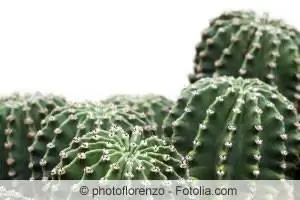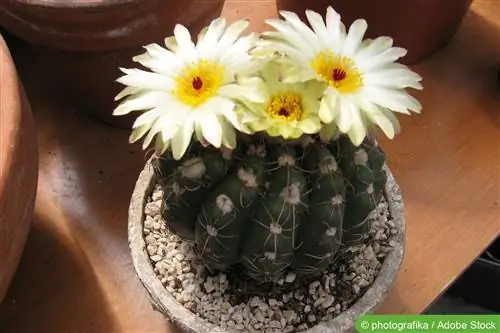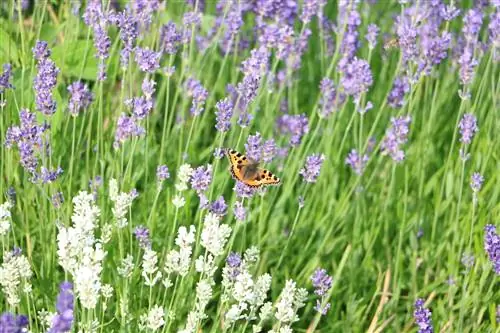- Author admin [email protected].
- Public 2023-12-17 03:39.
- Last modified 2025-06-01 06:48.
In the warm months, extend your vacation in your own garden with a seductive scent - this is possible if lavender has been cultivated. But be careful, because not all of the many lavender varieties are hardy and can survive a winter in the garden bed without damage in these latitudes. But some varieties of the popular herb plant can also grow in the home garden for several years and bring the garden owner a lot of joy over the summer months. The hardy varieties and tips for overwintering are presented here.
Wintering
Lavender is originally native to the Mediterranean countries and who doesn't know the fragrant, blue-flowering fields in Provence in France and Tuscany in Italy. The plants are therefore used to sun and warmth, but are not used to sub-zero temperatures in winter. However, with a few tips on overwintering, some of the approximately 25 - 30 registered lavender varieties can survive even harsher winters in the local latitudes when cultivated in the garden bed. The following information must be strictly observed, because even if these are winter-hardy varieties, they still need to be well protected from frosty days and nights:
- Lavender that remains in the garden bed over the winter should be planted in spring
- Plants that are already well established survive a harsher winter better
- In winter, when the ground is frozen, lavender can dry out more quickly if the sun also shines
- Adequate sun protection helps against this
- Suitable for this are brushwood branches, leaves or a mat made of straw spread over the ground around the lavender
- don't cut the lavender before winter
- otherwise the interfaces will dry out and there could also be a risk of frostbite and frost damage
- It is better to do the final cut in the summer after flowering
- It is better to additionally cover the lavender plant with plant fleece in case of severe frost
Tip:
All lavender varieties survive the winter well if they are grown in a pot. In this way they can easily be moved to protective winter quarters.
Winter-hardy lavender varieties
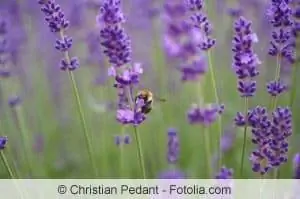
True Lavender (Landalula Angustifolia)
The real lavender, which is also known as “little Speik”, originally grows wild in the Mediterranean countries, especially in Italy, France and Greece. Because it prefers high altitudes with dry, barren and calcareous soils, it is very robust and is one of the lavender varieties that can withstand a domestic winter. Real lavender is popular because of its oil, but when cultivated in the well-known fields in Italy and France, it is increasingly being replaced by breeding and crossing other lavender varieties. But it is perfect for home gardens because of its winter hardiness. Real lavender is characterized primarily by the following features:
- perennial plant
- reaches a height of between 30 and 50 cm
- some plants up to 80 cm high
- dark purple flowers to almost black, like an amethyst
- Flowers form on long panicles
- intense sweet and very complex scent
- green leaves with blue shimmer
- Leaves with a square shape
- strong seed formation
- often self-sowing
- sunny location preferred
- must not dry out, but avoid waterlogging
Tip:
The real lavender is particularly suitable for gardens that are located in a very frosty and cold winter region. Despite everything, the tips for overwintering in the garden bed should be heeded.
Various cultivars have emerged from real lavender, which can also remain in the garden bed with protection in local gardens in winter. These include:
Blue Scent
- a low and compact breed
- dark blue flowers
- Growth height 25 - 40 cm
Dwarf Blue
- is often used dried for decorative purposes
- dark purple flowers
- Growth height about 30 cm
The English beauty Hidcote Blue
- bred in England
- very robust
- dark purple flowers
- Growth height about 50 cm
Provence lavender (lavandin)
Provence lavender is a cross between real lavender and spit lavender. It prefers low altitudes. Since it is a hybrid, it is unable to reproduce on its own. If you want to propagate Provence lavender in your garden, you have to help it and plant cuttings. It is only partially hardy, which means that it needs to be protected in the garden bed over the winter. But this usually works well and so every hobby gardener can enjoy their Lavandin for a long time, which is characterized above all by the following features:
- very bushy
- half-shrub
- can reach a height of up to one meter
- blooms from July to August
- often smells of camphor
- blooms in a very intense blue
Tip:
The Provence lavender is a variety that is mainly grown in the large fields of Provence.
Flower Lavender (Lavendula Stoechas)
The crested lavender is considered one of the most beautiful cultivated varieties of lavender. Although it is cultivated, this lavender appears very wild in appearance. It can also be cultivated in the garden bed at local latitudes because it is partially hardy. With a cover in winter, it also survives the cold season well and will delight hobby gardeners for many years with its great flowers in summer and its pleasant scent. In its homeland it prefers sandy soil, which can be found near the sea or at the foot of mountains. Already from its name Schopflavender, its characteristics can be deduced:
- “studded” appearance due to large and wide flower spikes
- The flowers appear on the upper part of each panicle, giving it a hair-like appearance
- the flowers vary between pink and light purple
- With its 10 - 50 cm, the crested lavender is one of the smaller lavender varieties
- narrow, long, green leaves complete the picture
Woolly Lavender/Silverleaf Lavender (Lavandula Lanata Boiss)
As the name suggests, woolly lavender is characterized by silvery and hairy leaves that look as if they are covered in wool. This hairiness serves the plant primarily as protection against evaporation; it is an adaptation to the heat of its original home in southern Spain. But although woolly lavender is very sun and heat-drenched, it can also overwinter well in the garden bed with protection in these latitudes. In addition to its leaves, the following features characterize silver leaf lavender:
- will be between 50 - 75 cm high but up to 90 cm wide
- dark, purple-violet flowers
- sweet scent of camphor
- found growing wild at 1200 meters to 1700 meters altitude
- dense, low and bushy shape
- conditionally frost hardy down to -5° Celsius
White Lavender (Lavandula angustifolia Alba)
It's not just blue and violet varieties that delight hobby gardeners, white lavender is also hardy and can be cultivated in garden beds in these latitudes. This variety originally grows in sunny locations with dry, sometimes rocky soil. The special thing about white lavender is that it still shines out of the bed with its white color even in the evening or on dark days, when the dark varieties can no longer be seen. Other characteristics of white lavender:
- grows up to 40 cm high
- lanceolate, silver-grey leaves
- white flowers on long spikes
- Flowering time is in June and July
- strong, pleasant scent
- grows bushy
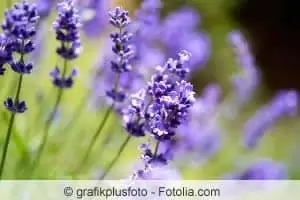
Tip:
If you want to set accents in your garden bed with the different types of lavender, you can also mix several white-flowering plants among the blue and purple lavender bushes. Since all of the varieties presented here are more or less winter hardy, the entire garden bed as a whole can be made suitable for winter. The hobby gardener can expect new flowers and a pleasant scent next summer.
Conclusion
Not all of the approximately 25 to 30 lavender varieties are suitable for cultivation in the garden bed. If you still want this, you have to use the winter-hardy and partially winter-hardy varieties presented here. In areas with a mild winter climate, these varieties do not need additional protection; if the winters are harsh and very frosty, the hardy varieties also need sufficient protection. But this is quickly given and the lavender can bring a lot of joy, scent and a feeling of beach, sea and vacation to your own garden bed for several years.


